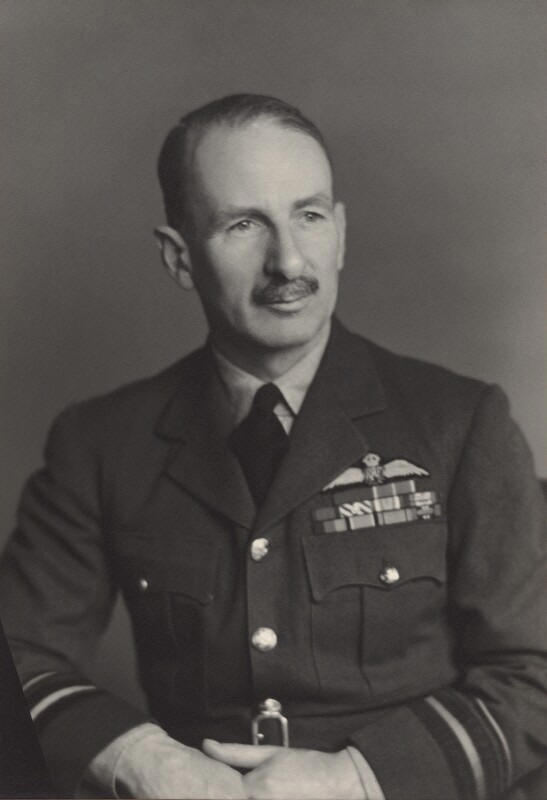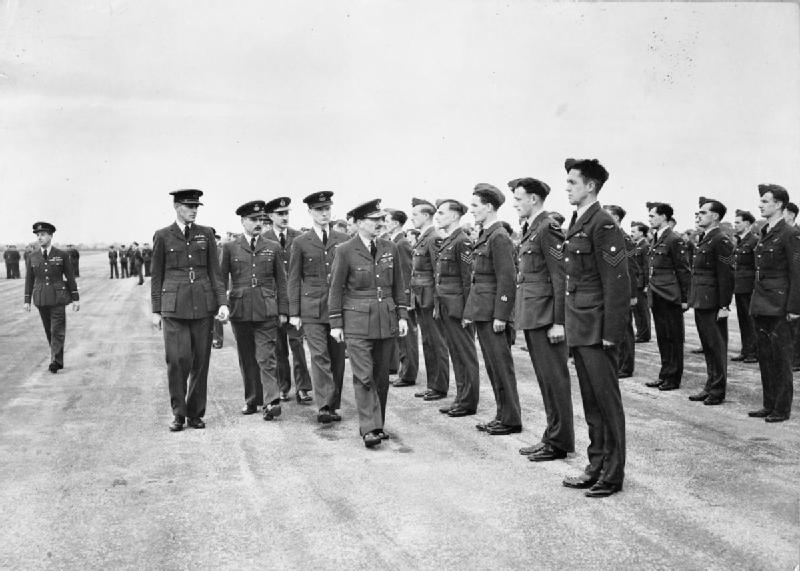Robert Stewart Blucke
by Walter Stoneman
bromide print, 15 November 1948
NPG x165346
Air of Authority - A History of RAF Organisation
 Robert
Stewart
b: 22 Jun 1897
r: 1 Jul 1952
d: 2 Oct 1988
Robert
Stewart
b: 22 Jun 1897
r: 1 Jul 1952
d: 2 Oct 1988
CB
-
1 Jan
1946, CBE -
14 Jun
1945, DSO -
5 Oct 1943,
AFC - 11 May 1937, Bar - 1 Jul
1941,
MiD - 2 Jun 1943,
MiD – 1
Jan 1945.
(Army):
- 2 Lt (P): 9 Jan 1915,
(RAF): - (H) Lt [2 Lt]: 24 Apr 1918, Plt Off (P): 9 Dec 1922, Fg Off: 9 Jul 1924, Flt Lt: 10 Oct 1928, Sqn Ldr: 1 Oct 1936, (T) Wg Cdr: 1 Jan 1940, (T) Gp Capt: 1 Sep 1941, Wg Cdr: 14 Apr 1942 [1 Jan 1940], Act A/Cdre: 1 Jan 1944, (T) A/Cdre: 1 Oct 1944, Gp Capt: 1 Dec 1944, Act AVM: 5 Feb 1945, (T) AVM: 1 Jan 1946, A/Cdre (WS): 12 Feb 1946, A/Cdre: 1 Apr 1946, AVM: 1 Jul 1947.
Robert Stewart Blucke
by Walter Stoneman
bromide print, 15 November 1948
NPG x165346
xx xxx 1914: Officer Cadet, Cambridge University OTC (St Catherine's College).
9
Jan 1915:
Officer,
3rd
Battalion, Dorsetshire Regiment
22 Apr - 2 May 1917: Acting Company Commander, 2nd Battalion, Dorsetshire Regiment.
24
Apr 1918:
Observer, No 63 Sqn.
20 Sep 1918: Returned to Home Establishment
6 Jan 1919: Supernumerary, HQ Midland Area (for disposal)
6 Jan 1919: Supernumerary, HQ No 12 Group.
7 Jan 1919: U/T Pilot, No 40 Training Depot Station.
29 Jan 1919: U/T Pilot, No 59 Training Depot Station.
5 Mar 1919: Transferred to Unemployed List.
1 Apr 1920: Relinquished his Commission, retaining the rank of Lieutenant
9 Dec 1922: Appointed to a Short Service Commission (4 years)
19
Dec 1922: U/T Pilot, No 2 FTS.
1 Dec 1923: Supernumerary, RAF Depot.
1
Mar 1924: Staff/QFI, RAF College - Cranwell.
5
Jan 1925: Pilot, No 29 Sqn.
10
Jan 1927: Attended Electrical and Wireless School.
28 Jul 1927: Successfully completed the long course in Signals and awarded the symbol 'S'.
20
Sep 1927: Signals Officer, No 31 Sqn.
20
Nov 1929: Signals Officer, Aircraft Depot, India.
16
Dec 1932: Supernumerary, RAF Depot.
23
Mar 1933: Staff, Anti Aircraft Co-operation Flight, Biggin Hill.
6
Jan 1934:
Signals Officer, Experimental Section, RAE.
17
Jan 1938: Signals Staff, HQ Bomber Command.
23
May 1938: Supernumerary, HQ No 6 (Auxiliary) Group.
1 Jan 1939: Supernumerary, No 6 (Bomber) Group
3 Apr 1939: Supernumerary, HQ No 50 (Training) Group.
3 Sep 1939: Air Staff, Directorate of Training.
1 Oct 1939:
Officer Commanding, Blind Approach Training and Development Unit.
7 Jun 1940: Staff Officer, HQ Bomber Command
13 Jun 1940:
Officer Commanding, Blind Approach Training and Development Unit.
18 Jun 1940: Assumed command of investigations into German radio beams
30
Sep 1940: Officer Commanding, Wireless Investigation Development Unit.
11
Nov 1940: Air Staff, Directorate of Flying Training.
3 Jun 1942: Officer Commanding, RAF Holme on Spalding Moor
31 Jan - 4 Feb 1943: Attended a Course in Aviation Medicine, RAE Farnborough
15 Jun 1943:
1 Jan 1944: Base Commander, No 14 Base (On leave from 5 to 16 Jan 1944)
5
Feb 1945: AOC, No 1 (Bomber) Group.
27
Nov 1946: SASO, AHQ India.
15 Aug 1947: SASO, RAF Units in India and Pakistan
1
Dec 1947: AOA, HQ Technical Training Command.
xx
May 1949:
AOA, HQ Far East Air Force.
22
Jan 1951: AOC, AHQ Malaya.

AVM Robert Stewart Blucke, AOC 1 Group inspecting personnel at a Bomber Command airfield during 1945
Photo courtesy - Norman Hood
It was Sqn Ldr Blucke who flew the Heyford bomber used in Watson Watt's 'Daventry Experiment' which led to the development of Britain's radar system, which was instrumental in winning the Battle of Britain. He was a representative of the RAF at the funeral of King George VI. He retired at his own request.
“Group Captain Robert Stewart BLUCKE, A.F.C., Royal Air Force.
One night in September, 1943, Group Captain Blucke was the captain of a Lancaster aircraft detailed to attack a target at Mannheim. During the outward flight the rear turret became unserviceable and, owing to icing, the elevator trimming gear jammed and rendered the bomber almost uncontrollable. Assisted by another member of the crew Group Captain Blucke skilfully maintained control and proceeded to the target, which was bombed and photographed. The aircraft was then flown safely back to base. Group Captain Blucke has participated in a number of sorties in recent months and ,by his personal example and magnificent leadership, has produced a high standard of efficiency in the personnel at the station he commands.”
(London Gazette – 5 October 1943)
BLUCKE, Robert Stewart, S/L - Air Force Cross - awarded as per London Gazette dated 11 May 1937 in Coronation Honours List
Recommendation drafted 14 October 1936 by Commanding Officer, Experimental Section, Royal Aeronautical Establishment. Blucke was then an experimental and test pilot at the Royal Aeronautical Establishment.
"Squadron Leader Blucke has during the last year carried out a large number of blind flying experiments in connection with directional wireless. In the course of these experiments he has been called upon to fly through and land in fog so dense that difficulty has been experienced in locating his aircraft on the aerodrome after it has come to rest.
He has also been responsible for a long programme of experimental night flying required to test new methods of aerodrome illumination and new types of night flying equipment. These flights have been carried out irrespective of weather conditions.
He is at present engaged on important work for the Tizard Committee which necessitated flying under the very worst conditions, i.e. through clouds at night. He was selected for these duties on account of his special qualifications.
Squadron Leader Blucke is well aware of the risks he takes but does not allow these to interfere with his work which is invariably of the highest quality."
On 15 October 1936, A.H. Hall (Superintendent, Royal Aeronautical Establishment) added his remarks:
"I agree - a very exceptional pilot whose balance and judgement is not effected in the slightest by the very difficult work he performs so well."
(Source - Air 2/2348)
BLUCKE, Robert Stewart, W/C, AFC (17102, Royal Air Force) - Head of Training Flight No.4, Department of Air Member for Training - Bar to Air Force Cross - awarded as per London Gazette dated 1 July 1941. P
"A pioneer in the development of Blind Approach flying, this officer has, by his constant flying in all weather, acquired an unrivalled experience in the problems, enabling him to train a number of instructors with outstanding results. Through his inspiration and disregard of personal risk, he has made a great contribution to the advancement of flying."
(Source - Air 2/8894)
BLUCKE, Robert Stewart, Acting A/V/M, DSO, AFC (17102, Royal Air Force) - No.1 Group Headquarters - Commander, Order of the British Empire - awarded as per London Gazette dated 14 June 1945.
"This officer joined Bomber Command in June 1942, prior to which he took a very active part in Blind Approach Training. He was appointed to command RAF Station Holme, and in June 1943 was selected to command No.14 Base. He is an outstanding officer in every way and has displayed such qualities as to justify his recent appointment as Air Officer Commanding, No.1 Group."
(Source - Air 9055 )
This entry was last updated on 09/12/25©
![]() J
H L Blount
J
H L Blount ![]()